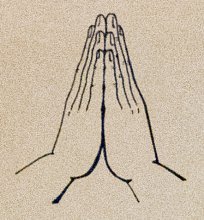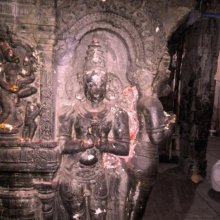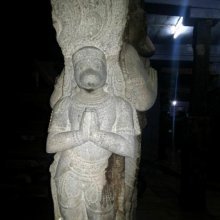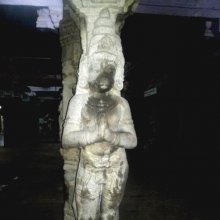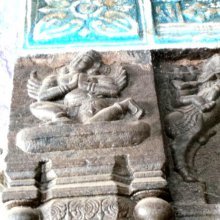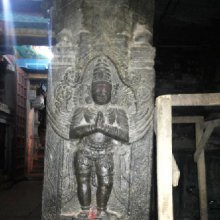Anjali, Añjali, Añjalī, Āñjali, Amjali: 32 definitions
Introduction:
Anjali means something in Buddhism, Pali, Hinduism, Sanskrit, Marathi, Hindi, biology. If you want to know the exact meaning, history, etymology or English translation of this term then check out the descriptions on this page. Add your comment or reference to a book if you want to contribute to this summary article.
Images (photo gallery)
(+72 more images available)
In Hinduism
Ayurveda (science of life)
Source: Wisdom Library: Āyurveda and botanyAñjali (अञ्जलि) is the Sanskrit word representing a measure of corn (sufficient to fill both hands when placed side by side). This measurement equals a single Kuḍava unit, which is a weight unit used throughout Ayurvedic literature.
Source: gurumukhi.ru: Ayurveda glossary of terms1) Añjali (अञ्जलि):—Indicating measure Synonym of one kudava = 192 g of metric units
2) A measure sufficient to fill both hands when placed side by side

Āyurveda (आयुर्वेद, ayurveda) is a branch of Indian science dealing with medicine, herbalism, taxology, anatomy, surgery, alchemy and related topics. Traditional practice of Āyurveda in ancient India dates back to at least the first millenium BC. Literature is commonly written in Sanskrit using various poetic metres.
Purana and Itihasa (epic history)
Source: archive.org: Puranic EncyclopediaĀñjali (आञ्जलि).—A sage who was a classmate of Śaunaka. (Skandha 12, Bhāgavata).
Source: archive.org: Shiva Purana - English TranslationAñjali (अञ्जलि) refers to “(having the) palms joined in reverence”, according to the Śivapurāṇa 2.3.15 (“The penance and reign of Tārakāsura”).—Accordingly, as Brahmā narrated: “Thus with ardour, the king of the demons [i.e., Tāraka] performed the severe penance duly unbearable even to those who heard about it. [...] Then all those gods and sages consulted one another and in their great fright they came to my world and approached me in a piteous plight. Bowing to and eulogising me with palms joined in reverence [i.e., añjali], all of them explained everything to me distressed in mind that they were. [...]”.
Source: Cologne Digital Sanskrit Dictionaries: The Purana IndexAñjali (अञ्जलि).—A mode of worship with both hands. He who worships a god by raising only one hand is liable to have that hand cut off.*
- * Bhāgavata-purāṇa X. 22. 19[1-3].

The Purana (पुराण, purāṇas) refers to Sanskrit literature preserving ancient India’s vast cultural history, including historical legends, religious ceremonies, various arts and sciences. The eighteen mahapuranas total over 400,000 shlokas (metrical couplets) and date to at least several centuries BCE.
Natyashastra (theatrics and dramaturgy)
Source: Wisdom Library: Nāṭya-śāstraAñjali (अञ्जलि) refers to a gesture (āṅgika) made with ‘combined hands’ (saṃyuta), according to the Nāṭyaśāstra chapter 8. The hands (hasta) form a part of the human body which represents one of the six major limbs (aṅga) used in dramatic performance. With these limbs are made the various gestures (āṅgika), which form a part of the histrionic representation (abhinaya).
Source: archive.org: Natya ShastraAñjali (अञ्जलि).—A type of gesture (āṅgika) made with combined hands (saṃyuta-hasta);—(Instructions): Putting together of the two Patāka hands is called Añjali.
(Uses): It is used to greet gods, venerable persons (guru) and friend. In greeting gods it is to be held on the head, in case of venerable persons like father, teacher etc. it is to be held near one’s face, and for greeting the friends it is to be placed on the chest and in case of the remaining persons there is no fixed rule.
Source: Shodhganga: Elements of Art and Architecture in the Trtiyakhanda of the Visnudharmottarapurana (natya)Añjalī (अञ्जली) refers to one of the thirteen Saṃyuktahastas or “combined hand gestures” (in Indian Dramas), according to the Viṣṇudharmottarapurāṇa, an ancient Sanskrit text which (being encyclopedic in nature) deals with a variety of cultural topics such as arts, architecture, music, grammar and astronomy.—The hasta-mudrās (lit. “hand-gestures”) are very essential to denote some particular action or state in dancing and these mudrās are formed with the help of hands and fingers.—The word añjali denotes a cavity made by folding and joining the open hands together or the hollow of the hands. According to the Viṣṇudharmottarapurāṇa, añjalī-hasta is a combination of patāka-hasta which is used in the salutation of gods, teachers and ancestors. The Abhinayadarpaṇa also gives its view point in the same way
Source: ORA: Amanaska (king of all yogas): (Natya)Añjali (अञ्जलि) is considered [to be formed] from joining the two hands [which are held in] the Patāka [gesture. It is used] in the respectful salutation of Gods, Gurus and friends. It has three positions: the chest, the mouth and head. For Gods, it is situated on the head, for Gurus, [near] the mouth and for friends, [in front of] the chest. For women, it's [position] should be unrestricted

Natyashastra (नाट्यशास्त्र, nāṭyaśāstra) refers to both the ancient Indian tradition (shastra) of performing arts, (natya—theatrics, drama, dance, music), as well as the name of a Sanskrit work dealing with these subjects. It also teaches the rules for composing Dramatic plays (nataka), construction and performance of Theater, and Poetic works (kavya).
Pancaratra (worship of Nārāyaṇa)
Source: archive.org: Isvara Samhita Vol 1Añjali (अञ्जलि) refers to a measurement to fill up the palms when folded to form a hollow.

Pancaratra (पाञ्चरात्र, pāñcarātra) represents a tradition of Hinduism where Narayana is revered and worshipped. Closeley related to Vaishnavism, the Pancaratra literature includes various Agamas and tantras incorporating many Vaishnava philosophies.
Shilpashastra (iconography)
Source: Shodhganga: The significance of the mūla-beras (śilpa)Añjali (अञ्जलि) or Añjalihasta refers to “devotion” and represents one of the four gestures with both hands, as defined according to texts dealing with śilpa (arts and crafs), known as śilpaśāstras.—Accordingly, pratimā-lakṣaṇa (body postures of the icons) is comprised of hand gestures (hasta, mudrā or kai-amaiti), stances/poses (āsanas) and inflexions of the body (bhaṅgas). There are thirty-two types of hands [viz., añjali-hasta] classified into two major groups known as tolirkai (functional and expressive gestures) and elirkai (graceful posture of the hand).
Source: Shodhganga: Vaisnava Agamas And Visnu ImagesAñjali (अञ्जलि) or Añjalimudrā refers to one of the various hand-poses (hastas or mudrās) defined in treatises such as the Pāñcarātra, Pādmasaṃhitā and Vaikhānasa-āgamas, extensively dealing with the technical features of temple art, iconography and architecture in Vaishnavism.—Añjali-mudrā signifies salutation and adoration. In this saṃyuta hand-pose the open hands are placed side-by-side and slightly hollowed with the hands are clasped together with the palms touching together. Añjali-mudrā held close to the chest is called hṛdaya-añjali.

Shilpashastra (शिल्पशास्त्र, śilpaśāstra) represents the ancient Indian science (shastra) of creative arts (shilpa) such as sculpture, iconography and painting. Closely related to Vastushastra (architecture), they often share the same literature.
In Buddhism
Theravada (major branch of Buddhism)
Source: Pali Kanon: Pali Proper NamesOne of the nuns who accompanied Sanghamitta to Ceylon. Dip.xviii.24.
Theravāda is a major branch of Buddhism having the the Pali canon (tipitaka) as their canonical literature, which includes the vinaya-pitaka (monastic rules), the sutta-pitaka (Buddhist sermons) and the abhidhamma-pitaka (philosophy and psychology).
Mahayana (major branch of Buddhism)
Source: academia.edu: A Study and Translation of the GaganagañjaparipṛcchāAñjali (अञ्जलि) refers to “joining the palms of one’s hands”, according to the Gaganagañjaparipṛcchā: the eighth chapter of the Mahāsaṃnipāta (a collection of Mahāyāna Buddhist Sūtras).—Accordingly: “[...] Then the robbers released the five hundred men to be killed because of vices caused by their greed, and killed the magically conjured-up men. Then they, freed from the robbers, found their relief from the fear and terror of being killed, went to the place where the Bodhisattva Gaganagañja stayed, bowed down at the feet of the Buddha, joined the palms of their hands (añjali), bowed to the Bodhisattva Gaganagañja, and said: ‘We survived and found relief because of you, O Good man, please teach us the dharma which is the entrance into development for myself and others, because one can make progress in the dharma’. [...]
Source: De Gruyter: A Buddhist Ritual Manual on AgricultureAñjali (अञ्जलि) refers to “(bowing with one’s) hands put together”, according to the Vajratuṇḍasamayakalparāja, an ancient Buddhist ritual manual on agriculture from the 5th-century (or earlier), containing various instructions for the Sangha to provide agriculture-related services to laypeople including rain-making, weather control and crop protection.—Accordingly, [after the Bhagavān entered the assembly of Nāgas], “Then the Four Great Kings bowed to the Bhagavān with their hands put together (añjali) and addressed him, “O Bhagavān, extremely frightening great dangers have arisen in the world. Namely, drought, famine, calamities. O Bhagavān, all beings have become defenceless and refugeless because of this misfortune. [...]’”.

Mahayana (महायान, mahāyāna) is a major branch of Buddhism focusing on the path of a Bodhisattva (spiritual aspirants/ enlightened beings). Extant literature is vast and primarely composed in the Sanskrit language. There are many sūtras of which some of the earliest are the various Prajñāpāramitā sūtras.
Biology (plants and animals)
Source: Wisdom Library: Local Names of Plants and DrugsAnjali [அந்ஜலீ] in the Tamil language is the name of a plant identified with Volkameria inermis L. from the Verbenaceae (Verbena) family having the following synonyms: Clerodendrum inerme, Clerodendrum ovalifolium. For the possible medicinal usage of anjali, you can check this page for potential sources and references, although be aware that any some or none of the side-effects may not be mentioned here, wether they be harmful or beneficial to health.
Source: Google Books: CRC World Dictionary (Regional names)1) Anjali in India is the name of a plant defined with Artocarpus hirsutus in various botanical sources. This page contains potential references in Ayurveda, modern medicine, and other folk traditions or local practices It has the synonym Artocarpus hirsuta Lam..
2) Anjali is also identified with Clerodendrum inerme It has the synonym Volkameria commersonii Poir. (etc.).
3) Anjali is also identified with Crateva nurvala It has the synonym Crateva lophosperma Kurz (etc.).
4) Anjali is also identified with Senna alata It has the synonym Cassia bracteata L.f. (etc.).
Example references for further research on medicinal uses or toxicity (see latin names for full list):
· Phytologia (1978)
· Transactions of the Linnean Society of London (1827)
· Prodromus Florae Novae Hollandiae (1810)
· Journal of Ethnopharmacology (2005)
· Blumea (2006)
· Forest Flora of British Burma (1877)
If you are looking for specific details regarding Anjali, for example pregnancy safety, diet and recipes, side effects, health benefits, extract dosage, chemical composition, have a look at these references.

This sections includes definitions from the five kingdoms of living things: Animals, Plants, Fungi, Protists and Monera. It will include both the official binomial nomenclature (scientific names usually in Latin) as well as regional spellings and variants.
Languages of India and abroad
Pali-English dictionary
Source: BuddhaSasana: Concise Pali-English Dictionaryañjali : (f.) lifting of the folded hands as a token of reverence.
Source: Sutta: The Pali Text Society's Pali-English DictionaryAñjali, (cp. Sk. añjali, fr. añjati1) extending, stretching forth, gesture of lifting up the hands as a token of reverence (cp. E. to “tender” one’s respect), putting the ten fingers together and raising them to the head (VvA.7: dasanakha-samodhāna-samujjalaṃ añjaliṃ paggayha). Only in stock phrases (a.) añjaliṃ paṇāmeti to bend forth the outstretched hands Vin.II, 188; D.I, 118; Sn.352; Sn.p. 79. (b.) °ṃ paggaṇhāti to perform the a. salutation J.I, 54; DhA.IV, 212; VvA.7, 312 (sirasmiṃ on one’s head); PvA.93. (c.) °ṃ karoti id. PvA.178; cp. katañjali (adj.) with raised hands Sn.1023; J.I, 17; PvA.50, and añjalikata id. Pv.II, 1220. Cp. pañjali

Pali is the language of the Tipiṭaka, which is the sacred canon of Theravāda Buddhism and contains much of the Buddha’s speech. Closeley related to Sanskrit, both languages are used interchangeably between religions.
Marathi-English dictionary
Source: DDSA: The Molesworth Marathi and English Dictionaryañjali (अंजलि).—m f (S) añjalipuṭa m n (S) pop. añjaḷī f The cavity formed by putting the hands side by side, hollowing the palms; Scottice, gowpen. a0 jōḍaṇēṃ To apply the palms together rather hollowed or curved;--as in humble or respectful address.
Source: DDSA: The Aryabhusan school dictionary, Marathi-Englishañjali (अंजलि).—m f -ḷī f añjalipuṭa m n The hollow formed by joining the two hands together.
Marathi is an Indo-European language having over 70 million native speakers people in (predominantly) Maharashtra India. Marathi, like many other Indo-Aryan languages, evolved from early forms of Prakrit, which itself is a subset of Sanskrit, one of the most ancient languages of the world.
Sanskrit dictionary
Source: DDSA: The practical Sanskrit-English dictionaryAñjali (अञ्जलि).—m. [añj-ali Uṇādi-sūtra 4.2.]
1) A cavity formed by folding and joining the open hands together, the hollow of the hands; hence, a cavity. full of anything (changed to añjala or °li after dvi and tri in dvigu comp., P.V.4.12); न वार्यञ्जलिना पिवेत् (na vāryañjalinā pivet) Manusmṛti 4.63; सुपूरो मूषि- काञ्जलिः (supūro mūṣi- kāñjaliḥ) Pañcatantra (Bombay) 1.25; अरण्यबीजाञ्जलिदानलालिताः (araṇyabījāñjalidānalālitāḥ) Kumārasambhava 5.15; प्रकीर्णः पुष्पाणां हरिचरणयोरञ्जलिरयम् (prakīrṇaḥ puṣpāṇāṃ haricaraṇayorañjalirayam) Ve.1.1. a cavityful of flowers; so जलस्याञ्जलयो दश (jalasyāñjalayo daśa) Y.3.15.1 cavityfuls or libations of water; श्रवणाञ्जलिपुटपेयम् (śravaṇāñjalipuṭapeyam) Ve.1.4. to be drunk by the cavity of the ear; अञ्जलिं रच्, बन्ध्, कृ (añjaliṃ rac, bandh, kṛ) or आधा (ādhā) fold the hands together and raise them to the head in supplication or salutation; बद्धः, कातर्यादरविन्द- कुङ्मलनिभो मुग्धः प्रणामाञ्जलिः (baddhaḥ, kātaryādaravinda- kuṅmalanibho mugdhaḥ praṇāmāñjaliḥ) Uttararāmacarita 3.37.
2) Hence a mark of respect or salutation; कः शक्रेण कृतं नेच्छेदधिमूर्धानमञ्जलिम् (kaḥ śakreṇa kṛtaṃ necchedadhimūrdhānamañjalim) Bhaṭṭikāvya 8.84; बध्यतामभययाचनाञ्जलिः (badhyatāmabhayayācanāñjaliḥ) R.11.78.
3) A measure of corn = कुडव (kuḍava); another measure = प्रसृत (prasṛta), or one-half of a मानिका (mānikā).
Derivable forms: añjaliḥ (अञ्जलिः).
Source: Cologne Digital Sanskrit Dictionaries: Shabda-Sagara Sanskrit-English DictionaryAñjali (अञ्जलि).—m.
(-liḥ) 1. The cavity formed by putting the hands together, and hollowing the palms: being in this form carried to the forehead, it forms the appropriate salutation from inferiors of respectabiliy to their superiors. 2. A measure, a Kud'ava. See kuḍava. E. añja to go, and lic Unadi aff.
Source: Cologne Digital Sanskrit Dictionaries: Benfey Sanskrit-English DictionaryAñjali (अञ्जलि).—m. 1. The cavity formed by putting the hands together and hollowing the palms, [Mānavadharmaśāstra] 4, 63. 2. This cavity as measure: two handfuls. 3. Putting the hands together and raising them to the forehead, as humble salutation of inferiors to their superiors.
Source: Cologne Digital Sanskrit Dictionaries: Cappeller Sanskrit-English DictionaryAñjali (अञ्जलि).—[masculine] the two hollowed hands put together (as a measure or a token of reverence). liṃ kṛ or bandh put the hands together and raise them to the forehead.
Source: Cologne Digital Sanskrit Dictionaries: Monier-Williams Sanskrit-English Dictionary1) Añjali (अञ्जलि):—[from añj] a See sub voce below.
2) b m. (√añj), the open hands placed side by side and slightly hollowed (as if by a beggar to receive food; hence when raised to the forehead, a mark of supplication), reverence, salutation, benediction
3) a libation to the Manes (two hands full of water, udakāñjali), [Viṣṇu-purāṇa etc.]
4) a measure of corn, sufficient to fill both hands when placed side by side, equal to a kuḍava.
Source: Cologne Digital Sanskrit Dictionaries: Goldstücker Sanskrit-English DictionaryAñjali (अञ्जलि):—m.
(-liḥ) 1) The two hands put together, the palms being slightly hollowed and in near contact with each other, when the hands are raised to the forehead as a reverential act of salutation or adoration: when employed in making offerings, or giving a benediction, the hands are left open only touching by the sides of the little fingers.
2) A measure, a Kuḍava, as much grain as can be held by the two hands put together. E. añj, uṇ. aff. alic.
Source: Cologne Digital Sanskrit Dictionaries: Yates Sanskrit-English DictionaryAñjali (अञ्जलि):—(liḥ) 2. m. Palm of the hand.
[Sanskrit to German]
Sanskrit, also spelled संस्कृतम् (saṃskṛtam), is an ancient language of India commonly seen as the grandmother of the Indo-European language family (even English!). Closely allied with Prakrit and Pali, Sanskrit is more exhaustive in both grammar and terms and has the most extensive collection of literature in the world, greatly surpassing its sister-languages Greek and Latin.
Hindi dictionary
Source: DDSA: A practical Hindi-English dictionaryAnjali in Hindi refers in English to:—(nf) the cup-shaped hollow formed by the joining of the two palms together; ~[gata] within one’s grasp, acquired; —[puta] the cup of one’s palms; ~[baddha] with the palms joined together..—anjali (अंजलि) is alternatively transliterated as Aṃjali.
...
Kannada-English dictionary
Source: Alar: Kannada-English corpusAṃjali (ಅಂಜಲಿ):—
1) [noun] the cavity formed by open hands joined together and folded slightly; the hollow of the palms.
2) [noun] that much which can be held by palms joined and folded slightly.
3) [noun] a hand gesture, in dancing, joining both the palms and holding the tips of the fingers pointing upward.
--- OR ---
Aṃjaḷi (ಅಂಜಳಿ):—[noun] = ಅಂಜಲಿ [amjali].
Kannada is a Dravidian language (as opposed to the Indo-European language family) mainly spoken in the southwestern region of India.
See also (Relevant definitions)
Starts with (+12): Amjalibaddha, Amjalibamdha, Amjalikarana, Amjalikarike, Amjalisu, Ancalikai, Ancalikal, Ancalikkai, Ancaliyitaiyar, Anjali Mudra, Anjalibandhana, Anjalihasta, Anjalika, Anjalikamma, Anjalikar, Anjalikaraniya, Anjalikari, Anjalikarika, Anjalikarman, Anjalikarmman.
Ends with (+69): Abaddhanjali, Avahitanjali, Baddhanjali, Bhagavatipadyapushpanjali, Bhamjali, Bhavapurna-shraddhanjali, Bijanjali, Brahmanjali, Cancali, Catupushpanjali, Chatupushpanjali, Danakusumanjali, Dhautanjali, Ekanjali, Gamjali, Gangapadyapushpanjali, Gangapushpanjali, Gitanjali, Hastanjali, Hridayanjali.
Full-text (+178): Anjalikarika, Pranjali, Anjala, Anjalikarman, Kritanjali, Anjalikrita, Baddhanjali, Anjalibandhana, Dvyanjala, Nyanjalika, Udanjali, Anjuli, Purnanjali, Anjalika, Jalanjali, Karnanjali, Sanjali, Anjaliputa, Hastanjali, Amjali.
Relevant text
Search found 66 books and stories containing Anjali, Añjali, Añjalī, Āñjali, Amjali, Aṃjali, Aṃjaḷi, Añjaḷi; (plurals include: Anjalis, Añjalis, Añjalīs, Āñjalis, Amjalis, Aṃjalis, Aṃjaḷis, Añjaḷis). You can also click to the full overview containing English textual excerpts. Below are direct links for the most relevant articles:
Charaka Samhita (English translation) (by Shree Gulabkunverba Ayurvedic Society)
Chapter 7 - The Enumeration of the Parts of the Body (sharira-sankhya) < [Sharirasthana (Sharira Sthana) — Section on Human Embodiment]
Chapter 12c - Table of Measures (mana) < [Kalpasthana (Kalpa Sthana) — Section on Pharmaceutics]
Garga Samhita (English) (by Danavir Goswami)
Verse 3.1.21 < [Chapter 1 - The Worship of Śrī Girirāja]
Verse 2.6.3 < [Chapter 6 - The Liberation of Aghāsura]
Verse 1.11.30 < [Chapter 11 - Description of Śrī Kṛṣṇacandra’s Birth]
Brihad Bhagavatamrita (commentary) (by Śrī Śrīmad Bhaktivedānta Nārāyana Gosvāmī Mahārāja)
Verse 2.4.73 < [Chapter 4 - Vaikuṇṭha (the spiritual world)]
Verse 2.2.112 < [Chapter 2 - Jñāna (knowledge)]
Verse 2.4.260 < [Chapter 4 - Vaikuṇṭha (the spiritual world)]
Hanuman Nataka (critical study) (by Nurima Yeasmin)
Hanuman-Nāṭaka, Act 9 (Summary) < [Chapter 3]
The Indian Buddhist Iconography (by Benoytosh Bhattachacharyya)
108 forms of Avalokiteśvara (4): Harihariharivāhana Lokeśvara
108 forms of Avalokiteśvara (22): Maṇipadma Lokeśvara
Ramayana of Valmiki (by Hari Prasad Shastri)
Chapter 45 - Rama and Lakshmana are struck down by Indrajita < [Book 6 - Yuddha-kanda]
